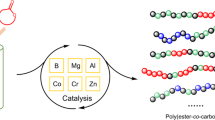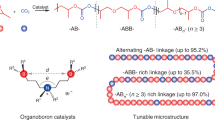Abstract
The catalytic coupling and polymerization of CO2 and epoxides has been studied for over 50 years. While traditionally dominated by catalytic systems containing cobalt, chromium, and zinc, the use of iron catalysts has emerged in the past 10 years. This review provides an overview of the homogeneous iron-catalyzed transformations of carbon dioxide and epoxides to yield cyclic and/or polycarbonates. It is important to note the potential for cyclic carbonates to be used as monomers for polymer formation via transesterification or by ring-opening polymerization in some cases, e.g., cyclohexene carbonate. Typical catalytic systems are composed of a Lewis acidic iron center and an anionic nucleophilic source, either through an anionic group weakly bound to the metal center or the addition of an external cocatalyst, cooperatively described as a binary catalytic system. This review is divided into two sections: (1) iron catalysts for cyclic carbonates and (2) iron catalysts for polycarbonates. At the end of each section, a table summarizes each catalytic system and the reaction conditions utilized in an attempt to provide a clearer comparison across the literature. Focus is given to highlighting differences in product selectivity, reaction conditions, and relative amounts of cocatalyst used.
This is a preview of subscription content, access via your institution
Access options
Subscribe to this journal
Receive 12 print issues and online access
$259.00 per year
only $21.58 per issue
Buy this article
- Purchase on Springer Link
- Instant access to full article PDF
Prices may be subject to local taxes which are calculated during checkout

















Similar content being viewed by others
References
Kätelhön A, Meys R, Deutz S, Suh S, Bardow A. Climate change mitigation potential of carbon capture and utilization in the chemical industry. Proc Natl Acad Sci USA. 2019;116:11187.
Cokoja M, Bruckmeier C, Rieger B, Herrmann WA, Kühn FE. Transformation of carbon dioxide with homogeneous transition-metal catalysts: a molecular solution to a global challenge? Angew Chem Int Ed. 2011;50:8510–37.
Liu Q, Wu L, Jackstell R, Beller M. Using carbon dioxide as a building block in organic synthesis. Nat Commun. 2015;6:5933.
North M, Styring P. Perspectives and visions on CO2 capture and utilisation. Faraday Discuss. 2015;183:489–502.
Aresta M, Dibenedetto A, Angelini A. Catalysis for the valorization of exhaust carbon: from CO2 to chemicals, materials, and fuels. Technological use of CO2. Chem Rev. 2014;114:1709–42.
Aresta M. Activation of small molecules. Wiley-VCH Verlag GmbH & Co. KGaA; Weinheim, Germany, 2006. pp 1–41.
Artz J, Müller TE, Thenert K, Kleinekorte J, Meys R, Sternberg A, et al. Sustainable conversion of carbon dioxide: an integrated review of catalysis and life cycle assessment. Chem Rev. 2018;118:434–504.
Inoue S, Koinuma H, Tsuruta T. Copolymerization of carbon dioxide and epoxide. J Polym Sci. 1969;7:287–92.
Kember MR, Buchard A, Williams CK. Catalysts for CO2/epoxide copolymerisation. Chem Commun. 2011;47:141–63.
Kozak CM, Ambrose K, Anderson TS. Copolymerization of carbon dioxide and epoxides by metal coordination complexes. Coord Chem Rev. 2018;376:565–87.
Poland SJ, Darensbourg DJ. A quest for polycarbonates provided via sustainable epoxide/CO2 copolymerization processes. Green Chem. 2017;19:4990–5011.
Small BL, Brookhart M, Bennett AMA. Highly active iron and cobalt catalysts for the polymerization of ethylene. J Am Chem Soc. 1998;120:4049–50.
Ittel SD, Johnson LK, Brookhart M. Late-metal catalysts for ethylene homo- and copolymerization. Chem Rev. 2000;100:1169–204.
Britovsek GJP, Bruce M, Gibson VC, Kimberley BS, Maddox PJ, Mastroianni S, et al. Iron and cobalt ethylene polymerization catalysts bearing 2,6-bis(imino)pyridyl ligands: synthesis, structures, and polymerization studies. J Am Chem Soc. 1999;121:8728–40.
Qi M, Dong Q, Wang D, Byers JA. Electrochemically switchable ring-opening polymerization of lactide and cyclohexene oxide. J Am Chem Soc. 2018;140:5686–90.
Delle Chiaie KR, Biernesser AB, Ortuño MA, Dereli B, Iovan DA, Wilding MJT, et al. The role of ligand redox non-innocence in ring-opening polymerization reactions catalysed by bis(imino)pyridine iron alkoxide complexes. Dalton Trans. 2017;46:12971–80.
Biernesser AB, Delle Chiaie KR, Curley JB, Byers JA. Block copolymerization of lactide and an epoxide facilitated by a redox switchable iron-based catalyst. Angew Chem Int Ed. 2016;55:5251–4.
Wei J, Riffel MN, Diaconescu PL. Redox control of aluminum ring-opening polymerization: a combined experimental and DFT investigation. Macromolecules. 2017;50:1847–61.
Wei J, Diaconescu PL. Redox-switchable ring-opening polymerization with ferrocene derivatives. Acc Chem Res. 2019;52:415–24.
Wang X, Thevenon A, Brosmer JL, Yu I, Khan SI, Mehrkhodavandi P, et al. Redox control of group 4 metal ring-opening polymerization activity toward L-lactide and Ε-caprolactone. J Am Chem Soc. 2014;136:11264–7.
Quan SM, Wang X, Zhang R, Diaconescu PL. Redox switchable copolymerization of cyclic esters and epoxides by a zirconium complex. Macromolecules. 2016;49:6768–78.
Lai A, Hern ZC, Diaconescu PL. Switchable ring-opening polymerization by a ferrocene supported aluminum complex. ChemCatChem. 2019;11:4210–18.
Kruper WJ, Swart DJ. US Patent 4,500,704, 1985.
Kruper WJ, Dellar DV. Catalytic formation of cyclic carbonates from epoxides and CO2 with chromium metalloporphyrinates. J Org Chem. 1995;60:725–7.
Darensbourg DJ, Rainey P, Yarbrough J. Bis-salicylaldiminato complexes of zinc. examination of the catalyzed epoxide/CO2 copolymerization. Inorg Chem. 2001;40:986–93.
Darensbourg DJ, Adams MJ, Yarbrough JC, Phelps AL. Synthesis and structural characterization of double metal cyanides of iron and zinc: catalyst precursors for the copolymerization of carbon dioxide and epoxides. Inorg Chem. 2003;42:7809–18.
Della Monica F, Buonerba A, Capacchione C. Homogeneous iron catalysts in the reaction of epoxides with carbon dioxide. Adv Synth Catal. 2019;361:265–82.
Shibasaki Y, Sanada H, Yokoi M, Sanda F, Endo T. Activated monomer cationic polymerization of lactones and the application to well-defined block copolymer synthesis with seven-membered cyclic carbonate. Macromolecules. 2000;33:4316–20.
Suriano F, Coulembier O, Hedrick JL, Dubois P. Functionalized cyclic carbonates: from synthesis and metal-free catalyzed ring-opening polymerization to applications. Polym Chem. 2011;2:528–33.
Tezuka K, Komatsu K, Haba O. The anionic ring-opening polymerization of five-membered cyclic carbonates fused to the cyclohexane ring. Polym J. 2013;45:1183–7.
Brignou P, Priebe GM, Casagrande O, Carpentier J-F, Guillaume SM. Polycarbonates derived from green acids: ring-opening polymerization of seven-membered cyclic carbonates. Macromolecules. 2010;43:8007–17.
Saito T, Takojima K, Oyama T, Hatanaka S, Konno T, Yamamoto T, et al. Trimethyl glycine as an environmentally benign and biocompatible organocatalyst for ring-opening polymerization of cyclic carbonate. ACS Sustain Chem Eng. 2019;7:8868–75.
Gao L, Dong B, Zhang J, Chen Y, Qiao H, Liu Z, et al. Functional biodegradable nitric oxide donor-containing polycarbonate-based micelles for reduction-triggered drug release and overcoming multidrug resistance. ACS Macro Lett. 2019;8:1552–8.
Marquis ET, Sanderson JR. US Patent 5,283,356, 1994.
Ji DF, Lu XB, He R. Syntheses of cyclic carbonates from carbon dioxide and epoxides with metal phthalocyanines as catalyst. Appl Catal A-Gen. 2000;203:329–33.
Jin L, Jing H, Chang T, Bu X, Wang L, Liu Z. Metal porphyrin/phenyltrimethylammonium tribromide: high efficient catalysts for coupling reaction of CO2 and epoxides. J Mol Catal A-Chem. 2007;261:262–6.
Buchard A, Kember MR, Sandeman KG, Williams CK. A bimetallic iron(Iii) catalyst for CO2/epoxide coupling. Chem Commun. 2011;47:212–14.
Dengler JE, Lehenmeier MW, Klaus S, Anderson CE, Herdtweck E, Rieger B. A one-component iron catalyst for cyclic propylene carbonate synthesis. Eur J Inorg Chem. 2011;3:336–43.
Sheng X, Qiao L, Qin Y, Wang X, Wang F. Highly efficient and quantitative synthesis of a cyclic carbonate by iron complex catalysts. Polyhedron. 2014;74:129–33.
Adolph M, Zevaco TA, Walter O, Dinjus E, Döring M. Easy-to-handle ionic transition metal complexes in the formation of carbonates from epoxides and CO2: A N4-ligand system based on N,N-bis(2-pyridinecarboxamide)-1,2-benzene. Polyhedron. 2012;48:92–8.
Adolph M, Zevaco TA, Altesleben C, Walter O, Dinjus E. New cobalt, iron and chromium catalysts based on easy-to-handle N4-chelating ligands for the coupling reaction of epoxides with CO2. Dalton Trans. 2014;43:3285–96.
Fuchs MA, Zevaco TA, Ember E, Walter O, Held I, Dinjus E, et al. Synthesis of cyclic carbonates from epoxides and carbon dioxide catalyzed by an easy-to-handle ionic iron(III) complex. Dalton Trans. 2013;42:5322–9.
Whiteoak CJ, Martin E, Martinez Belmonte M, Benet-Buchholz J, Kleij AW. An efficient iron catalyst for the synthesis of five- and six-membered organic carbonates under mild conditions. Adv Synth Catal. 2012;354:469–76.
Whiteoak CJ, Gjoka B, Martin E, Martinez Belmonte M, Escudero-Adan EC, Zonta C, et al. Reactivity control in iron(III) amino triphenolate complexes: comparison of monomeric and dimeric complexes. Inorg Chem. 2012;51:10639–49.
Whiteoak CJ, Martin E, Escudero-Adán E, Kleij AW. Stereochemical divergence in the formation of organic carbonates derived from internal epoxides. Adv Synth Catal. 2013;355:2233–9.
Buonerba A, De Nisi A, Grassi A, Milione S, Capacchione C, Vagin S, et al. Novel iron(III) catalyst for the efficient and selective coupling of carbon dioxide and epoxides to form cyclic carbonates. Catal Sci Technol. 2015;5:118–23.
Al-Qaisi FaM, Nieger M, Kemell ML, Repo TJ. Catalysis of cycloaddition of carbon dioxide and epoxides using a bifunctional Schiff case iron(III) catalyst. ChemistrySelect. 2016;1:545–8.
Alhashmialameer D, Collins J, Hattenhauer K, Kerton FM. Iron amino-bis(phenolate) complexes for the formation of organic carbonates from CO2 and oxiranes. Catal Sci Technol. 2016;6:5364–73.
Andrea KA, Brown TR, Murphy JN, Jagota D, McKearney D, Kozak CM, et al. Characterization of oxo-bridged iron amino-bis(phenolate) complexes formed intentionally or in situ: mechanistic insight into epoxide deoxygenation during the coupling of CO2 and epoxides. Inorg Chem. 2018;57:13494–504.
Andrea KA, Butler ED, Brown TR, Anderson TS, Jagota D, Rose C, et al. Iron complexes for cyclic carbonate and polycarbonate formation: selectivity control from ligand design and metal-center geometry. Inorg Chem. 2019;58:11231–40.
Fazekas E, Nichol GS, Shaver MP, Garden JA. Stable Fe(III) phenoxyimines as selective and robust CO2/epoxide coupling catalysts. Dalton Trans. 2018;47:13106–12.
Della Monica F, Maity B, Pehl T, Buonerba A, De Nisi A, Monari M, et al. [OSSO]-type iron(III) complexes for the low-pressure reaction of carbon dioxide with epoxides: catalytic activity, reaction kinetics, and computational study. ACS Catal. 2018;8:6882–93.
Cozzolino M, Leo V, Tedesco C, Mazzeo M, Lamberti M. Salen, salan and salalen iron(III) complexes as catalysts for CO2/epoxide reactions and ROP of cyclic esters. Dalton Trans. 2018;47:13229–38.
Kamphuis AJ, Milocco F, Koiter L, Pescarmona P, Otten E. Highly selective single-component formazanate ferrate(II) catalysts for the conversion of CO2 into cyclic carbonates. ChemSusChem. 2019;12:3635–41.
Driscoll OJ, Hafford-Tear CH, McKeown P, Stewart JA, Kociok-Köhn G, Mahon MF, et al. The synthesis, characterisation and application of iron(III)–acetate complexes for cyclic carbonate formation and the polymerisation of lactide. Dalton Trans. 2019;48:15049–58.
Nakano K, Kobayashi K, Ohkawara T, Imoto H, Nozaki K. Copolymerization of epoxides with carbon dioxide catalyzed by iron–corrole complexes: synthesis of a crystalline copolymer. J Am Chem Soc. 2013;135:8456–9.
Taherimehr M, Al-Amsyar SM, Whiteoak CJ, Kleij AW, Pescarmona PP. High activity and switchable selectivity in the synthesis of cyclic and polymeric cyclohexene carbonates with iron amino triphenolate catalysts. Green Chem. 2013;15:3083–90.
Taherimehr M, Serta J, Kleij AW, Whiteoak CJ, Pescarmona PP. New iron pyridylamino-bis(phenolate) catalyst for converting CO2 into cyclic carbonates and cross-linked polycarbonates. ChemSusChem. 2015;8:1034–42.
Acknowledgements
We would like to thank the Natural Sciences and Engineering Research Council of Canada (NSERC) for financial support, including a Discovery Grant (FMK). KAA is supported by a Vanier Canada Graduate Scholarship.
Author information
Authors and Affiliations
Corresponding author
Ethics declarations
Conflict of interest
The authors declare that they have no conflict of interest.
Additional information
Publisher’s note Springer Nature remains neutral with regard to jurisdictional claims in published maps and institutional affiliations.
Rights and permissions
About this article
Cite this article
Andrea, K.A., Kerton, F.M. Iron-catalyzed reactions of CO2 and epoxides to yield cyclic and polycarbonates. Polym J 53, 29–46 (2021). https://doi.org/10.1038/s41428-020-00395-6
Received:
Revised:
Accepted:
Published:
Issue Date:
DOI: https://doi.org/10.1038/s41428-020-00395-6



